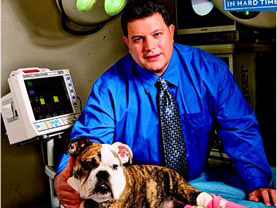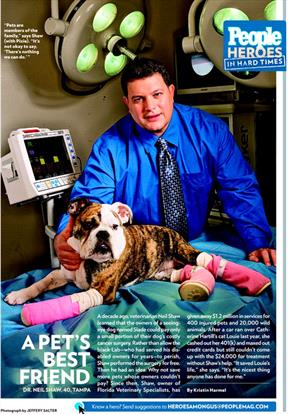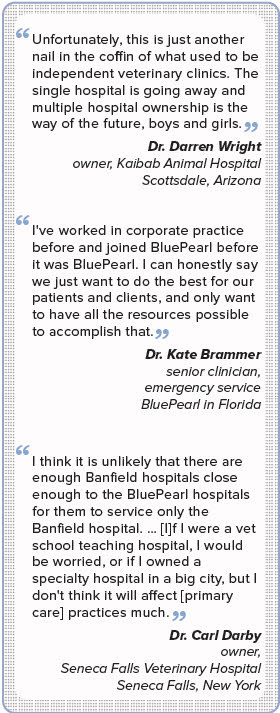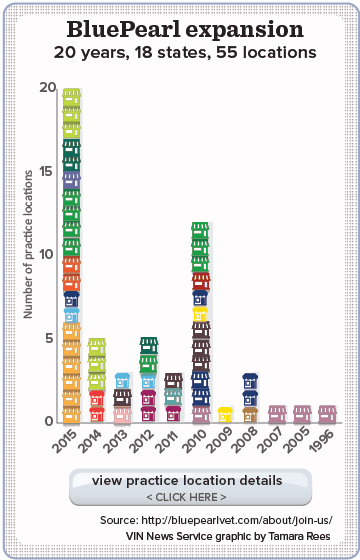

Screen shot from people.com
Dr. Neil Shaw was named a hero in 2009 by People magazine, which reported that he had given away $1.2 million in services for 400 injured pets and 20,000 wild animals. Shaw, 47, and his brother, Darryl, 49, opened their first practice in 1996. Twenty years later, their company is being acquired by Mars Petcare. Dr. Shaw said he expects under the new ownership to be able to continue donating services.
Click
here for larger view
As the son of a veterinarian, Dr. Neil Shaw has been in the veterinary field his whole life. He earned a DVM and completed a residency in small animal internal medicine at the University of Florida. In 1996, he and his brother, Darryl, an MBA, opened a specialty hospital with three employees in Tampa. By 2007, they were in three locations in Florida.
In 2008, the Shaws opened hospitals in New York City and merged with an existing specialty and emergency hospital in Kansas to form BluePearl Veterinary Partners. Since then, BluePearl has grown to 55 locations in 18 states. This month, BluePearl announced that it is being acquired by Mars Inc., a global company best known for making M&Ms. Its pet care subsidiary, however, is the company’s largest segment. Mars Petcare owns dog and cat food brands that include Pedigree, Iams, Whiskas and Royal Canin. It owns Banfield Pet Hospital, the largest chain of veterinary clinics in the world. Mars is privately held; the price it paid for BluePearl and other terms of the agreement have not been disclosed.
In a
letter to employees announcing the change, Shaw and other executives at BluePearl touted the alliance as bringing “unprecedented opportunities for growth and support.” Some employees echo their excitement, while others privately admit to feeling queasy. Many observers in the veterinary community are wary, concerned about the trend toward consolidated ownership of veterinary practices.
Dr. Shaw spoke at length with the VIN News Service about the Mars purchase. The following is an edited transcript.
Question: How did the conversation with Mars begin? Was BluePearl seeking a buyer?
Answer: We were not. It was unexpected. The Mars family approached us and asked if we would be interested.
[Our] initial reaction was a little bit of surprise because having somebody buy into the company wasn’t part of the immediate calculus. We’d been busy growing the company [by] speaking with hospitals to join us, as well as [growing through opening] new sites and expanding our existing locations. So we were all focused on growth. We weren’t focused on somebody purchasing us.
Q: What led you to accept the offer?
A: They’re a long-term, family-held company. We saw that as being a very good home for BluePearl. We wouldn’t want to look at a home where investors may come in and out or it may be sold. So being privately held, being owned by a family company and being able to look at the long-term was very attractive for us. That was really consistent with our culture.
In addition, we’ll be able to continue to maintain equity participation for current shareholders, as well continue to be able to offer [ownership share] in the future to individuals and to hospitals that join with us.
The other aspect — which is near and dear to my heart — is [that] our primary client is the primary care practitioner. As such, it’s very important not to do any primary care ourselves. The Mars folks are on board with this concept.
Q: You’ve called the move “exciting for our profession and the veterinary communities that we serve.” In what way is it exciting for the profession?
A: BluePearl’s brand, outside of a strong standard of care, has been built on providing great service to the primary care veterinarian. As we grow as an organization, and now with Mars helping us, I’m confident that we’ll be able to provide even greater service. [For example], where now communication revolves around telephone calls or fax of medical records … there are ways to communicate with veterinarians electronically that we haven’t [used] as an industry. That’s becoming a standard of human medicine, electronic communication between physicians. Potentially like developing portals to communicate with veterinary hospitals.
The other aspect is having the resources to truly identify how well of a job we are doing in serving an individual veterinary practice. Are they truly happy with what we’re doing, the care we’re providing and the service that we’re providing their clients? To learn that, to gather the information, to identify proactively when we’re doing a good job with service and when perhaps we need to do something better, that takes a significant amount of effort, a significant investment by hospitals.
As we refine the ability to receive feedback from the primary care veterinary community, we will be better able to improve our level of service to them. For example, we would like to be aware that we have made a mistake in communication with a primary care veterinarian
prior to them making the decision to refer cases elsewhere.
Q: In a
Q&A for employees, BluePearl said, “As part of Mars Petcare, our practice and clinicians will be able to make key investments in our associates, facilities, systems and infrastructure that would not be possible without Mars ownership.” What investments are you considering? Did BluePearl not have enough money for some project or venture?
A: We didn’t need the finances per se. We are fortunate to have hospitals with great teams that are well-equipped with advanced technologies, and mechanisms to deliver incredible patient care. However, as our profession grows, we identify that the level of sophistication necessary to provide the very best service to the larger veterinary community and clients is significant.
Q: What specific programs or goals do you have in mind?
A: Examples of ways that we will utilize Mars’ resources to develop referral medicine will include:
- Ability to solicit input from successful professionals in other service industries on how to develop the very best models for service
- Grow our internal team development/training capability
- Provide additional advancement opportunities for all team members
- Hopefully be able to increase our benefit package over time
- Grow the organization by expanding the number of BluePearl hospitals to reach more pets
- Increase the efficiency of the referral process for it to have a larger footprint within the veterinary community
Mind you, I don’t mean just to Banfield, to address the elephant in the room. We certainly would look to earn Banfield’s referrals but most importantly, we look to provide for the needs of an entire community, and this is larger than Banfield.

Q: Speaking of Banfield, BluePearl has stated that it will remain a separate business unit, but some predict that Mars inevitably will seek to be more efficient by eliminating executive positions and other jobs that are duplicative.
A: I don’t think they will. They’re a long-term multigenerational company, so they’re looking long-term. So whilst a short-term investor may look to maximize profits over the short term, we’re looking at the long term.
It’s hard to cut expenses and build for the future at the same time. They’re completely different models. Banfield is headquartered in Portland, Oregon, and is a primary care practice. BluePearl is headquartered in Tampa, Florida, and is a specialty referral practice. I don’t foresee a heckuva lot of crossover there. We had to feel confident in that in order to pursue this relationship with Mars.
Q: You mean you didn’t want to take yourself out of a job?
A: Correct. Or anyone else.
Q: As you know, Banfield has a mixed reputation among veterinarians. Did you have any hesitation about being perceived by colleagues or the public as the same as Banfield?
A: (Laughing.) Definitely. Definitely! ... We explored it thoroughly beforehand, because clearly, we anticipated these concerns.
I feel comfortable with Banfield. I think they’re progressing. From the time it started in practice in the mid ’90s to today, you see a consistent increase in quality of the practitioner in Banfield. I think they’ve come a long way. It’s been a huge change, especially since Mars took them over [in 1994].
Q: How do you gauge?
A: When you’re receiving cases from multiple veterinarians, it’s easy to see who’s doing a great job and who’s not necessarily doing a great job.
Q: So you had to get comfortable with being thought of in the same vein as Banfield?
A: We had to get comfortable that we’ll be able to maintain ourselves as an individual entity. And get comfortable that those [who] bring up some doubts — which, as expected, has happened — had to get comfortable that that sort of noise will die down over time as you continue to serve the community [and demonstrate that] we’re our own company.
Q: Will Banfield clients whose pets need specialist or emergency care be referred preferentially to BluePearl?
A: You’re going to raise your eyebrows when I say this: It hasn’t been discussed. It truly hasn’t been discussed. Now, I will say as well, I would hope so! (Laughing.) I can’t say for sure. We hope to earn their referrals based on the merits of our service to them.
Q: Conversely, will BluePearl direct its clients to Banfield for primary care?
A: Absolutely not. We maintain independence. In fact, the protocol is, say a client comes in after hours with an emergency, say they just moved to the area and don’t have a general practitioner, we’ll give them the names of several veterinarians in their ZIP code.
Certainly, we will have a relationship with Banfield … but Banfield will not receive preferential treatment over other hospitals.
Q: Some general practitioners have expressed reluctance to refer clients to BluePearl now that you’ll have the same owner as Banfield, their competitor. What is your reaction to this?
A: I think that’s false logic. I think that ultimately, they should feel comfortable to refer to the entity or the hospital that provides them and their client and patients with the best service. If I were a pet owner and went to that primary care practice, I’d ask the veterinarian, “Where would you want to take your dogs [based on] the care provided?” They should not base referrals on business decisions.
Q: Will BluePearl want or be expected to sell Mars-brand pet foods in its facilities?
A: We won’t be selling M&Ms. (Laughing.) We actually sell very little food. There has not been an expectation in any discussion that we’d provide only foods that are owned by Mars brand. Remember, we don’t sell any maintenance foods. That’s for primary care practitioners to do. The only thing we sell is prescription diet, and we sell very little; it’s usually the first can or first bag and then [the client goes] back to the primary care practitioner.
Q: Would you be averse if Mars were to ask that you carry their foods preferentially?
A: That would be counter to what we’ve always done, which is to strongly support practitioner recommendations. There hasn’t been a company policy [on food brands]. In fact, I recently learned that Banfield sells a lot of Hill’s diets because that is what their doctors want to prescribe.

Q: What is BluePearl’s historic growth rate, and what growth do you anticipate under the new ownership?
A: In about a year and a half, we’ve doubled in size. [In] total, we have about 3,000 folks now who are part of BluePearl. About 750 [are] clinicians. It’s hard to say for the future. We certainly will work hard to continue to grow.
Q: You have no goal set?
A: No goal set. We’d like to continue to build … to help demonstrate leadership in the profession. Sometimes you only get a voice in that when you grow.
Q: Will acquisitions be limited to specialty and emergency care or might the company expand into general practice?
A: No general practice.
Q: I’m sure you’ve heard the concerns about the growth of corporate-owned practices and the loss of independent single hospitals. Many veterinarians see their industry going the way of pharmacy. What do you envision and hope for the future of veterinary practice ownership?
A: I actually think [individual ownership of general practices] will continue to be strong. I’m a half-full, not half-empty, kind of guy. … Veterinarians care. They care for the patient, they want to make families happy. That drives veterinary medicine more so than making money. I’m confident veterinarians are in control of their own destiny, as long as we prioritize pet care; as long as we prioritize the pet’s family.
I do think individual specialty hospitals will have a greater challenge. Specialty practice takes a level of sophistication that’s hard for stand-alone hospitals to [have]. … It’s more intensive with equipment. The cost to operate [a specialty practice], whether it be MRIs or CAT scans or staffing and personnel, I think it’s very expensive. [So is] the ability to really offer service, to be available at any time, 24/7, to offer quality continuing education programs, to do outreach and meet veterinarians in organized fashion ...
I think there will continue to be smaller specialty hospitals, like a local emergency clinic or a couple of specialists offering a niche service to niche market. But the concept of developing a large [independent] multi-specialty regional hospital, I think it will be harder.
Q: Your dad is a veterinarian. What kind of practice does he have?
A: My father [Dr. Brian Shaw] is a general practitioner. He originally is from South Africa. He had a practice in South Africa. We immigrated when Darryl and I were very young. In Florida, he and his business partner opened two practices, and to this day, [they] continue to practice. He has two partners at this point, and [their practices are] in Tampa. It’s the three of them, plus five or six veterinarians between the two hospitals.
[Darryl and I] learned very early, and it was easy for us, to identify as a specialty hospital providing service to the general practice. We could comfortably look at the profession through my father’s eyes.
Q: What is his opinion of corporate practices?
A: You’d have to ask him! (Laughing.) He is a practitioner through and through, and you’ll have to ask him!
Q: Where does the name BluePearl come from?
A: We had to come up with a name. I had opened up [the practices in] New York and we were merging with Kansas — we needed a common name. “Blue Pearl,” if you look up the definition in Eastern religions, means to meditate, and there’s a point of seeing the Blue Pearl light, which is a high level of enlightenment in which you identify spiritual purity. That’s kind of cool, it’s what we strive to achieve. And well, if you don’t like [the name], we thought, it’s in the background, anyway, it doesn’t matter.
Q: Did some or all of you practice meditation?
A: No! Nobody was a meditator. It was just something we came up with. Somebody brought it up as a suggestion. We liked the definition, we liked the goal.
Q: People magazine named you a hero in 2009 because of your penchant for giving away veterinary care. When you’re not the top boss, will you be able to continue donating your services to the same extent or at all?
A: Time will tell. But [Mars is] confident [about] us not changing our models, and so I would expect it to continue. It would be a surprise for me if it did not.
Q: Who will be your boss?
A: The BluePearl management will still run the company. No doubt Mars Medical, MMI, will have a say in the major decisions that we make. And it may be on, perhaps, a new hospital joining us, or such. (MMI owns Banfield.)
Q: Your job title is chief cultural officer. What is that?
A: I don’t know, okay? It came from the same place as BluePearl! I used to carry the title chief medical officer. As we continued to grow, we had Jennifer Welser, an ophthalmologist by training, join us as chief medical officer. She had been in San Francisco and joined us when we opened up in Manhattan. Never prevent somebody who’s better than you from doing the job!
[Now] my forte is to make sure we know we are who we are. What’s near and dear to me is to make sure we continue to maintain our identity, and if it evolves, it’s [to] something that’s meaningful to us.
Q: When did you last practice medicine?
A: It’s probably been about five years. Funny thing, I never saw myself as not practicing. It was my kids who pointed it out to me. I said, “Look, I’m a veterinarian.” They said, “You’re not a veterinarian!” Out of the mouths of babes. I love practice. I’m very busy with growing BluePearl and it was hard to do both.
Q: What are your personal aspirations? How will your own career continue to grow?
A: I hope to continue to do what I'm doing. We never anticipated growing so much. We’d like to continue doing that. I see veterinary medicine as an evolving process and I very much would like to be involved to help it evolve.